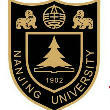MLSSA:
Center the microphone and position it as close to the
diaphragm or dust cap as possible without touching. In the case of open ports, position
the microphone's front face flush with the enclosure surface.
Make the first measurement by executing a Go Once command. Use FFT Execute to
compute the near-field transfer function of the port or driver in question. Save the
transfer function to an FRQ data file by executing Transfer Save from the frequency
domain. Use Go Once from the frequency domain to repeat this procedure for all ports,
drivers or passive radiators. Each measurement must be saved to a separate FRQ file.
A good idea is to use filenames that start with the same prefix and use a suffix that
clearly identifies the port or driver in question later on when it is time to combine the
files.
Measure the diameter of each port, driver or passive radiator and record these data on
a piece of paper for future reference. The diameters of the drivers should be measured
to include about 1/3 of the surround on each side.
If any port or radiator is not circular, you can alternatively use the square root of its area
to compute its effective diameter. For example, assume a loudspeaker having an
elliptical 6" by 9" passive radiator. These are nominal dimensions but in practice, you
should actually measure the diameters involved including about 1/3 of the surround on
each side. The area of an ellipse is (πab)/4 where a and b are the minor and major
diameter respectively. This area of this passive radiator is then 42.41 sq inches and
thus its effective diameter is √(42.41) = 6.51 inches.
When radiators or ports are mounted in vastly different planes further corrections are
required as explained below.
To properly combine all the near-field measurements execute Library Operations
Frequency-files Average Weighted Complex. Enter the directory where the near-field
measurement files reside followed by the file prefix you selected or just the file prefix if
they reside in the current directory. MLSSA will list all the FRQ files beginning with the
specified prefix. Use Spacebar or the left mouse button to mark all the near-field FRQ
files you just measured. Press the Ctrl-Enter key combination or the right mouse button
to exit the filebox. MLSSA will next display each filename in turn and prompt you to
enter the weighting factor for each. Enter these as the diameters you had previously
recorded making sure each corresponds to the correct filename. Finally, enter an
output filename to save the composite near-field low frequency response.
The resulting anechoic low frequency response can either be spliced to a far-field
Transfer-Function or Sensitivity measurement using the Library Operations Frequencyfiles
spLice command or, displayed as an offset overlay on top of the far-field anechoic
response.
The Library Operations Frequency-files spLice command will prompt you for the splice
frequency in Hz. If you enter nothing and press the Enter key, MLSSA will select a
splice frequency determined by the true resolution of the high frequency far-field
measurement file. This command adjusts the decibel level and phase delay of the low
frequency near-field file to smoothly connect it to the high frequency far-field file. The
output file contains the spliced measurements, which can be loaded into the frequency
domain and displayed through Transfer Load.
In case a port or woofer is mounted in a vastly different plane than the others, you need
to account for the acoustical delay between it and them. This is most easily
accomplished in the frequency domain through the View Phase Delay command.
Suppose a passive radiator is mounted at the rear of the enclosure with the woofer in
front and, suppose further that the enclosure is 2 feet deep. This requires that a delay
of about 2 ms be added to the passive radiator output before combining it with the other
radiators. To do this, load the rear port's FRQ file and execute View Phase Delay and
enter -2 ms. Next save the result to the original file and answer 'yes' when asked to
apply the phase delay correction to the saved data. You can now combine the FRQ
files according to the procedure given above.
Here are some points to remember when making near-field measurements. Near-field
loudspeaker measurements correctly predict the true anechoic far-field response only in
the driver's piston range of operation below roughly f = 4290/d Hz where d is largest
dimension of the largest diaphragm or port in inches.
Another limitation of the near-field method is that it does not account for sound
diffracted from the enclosure edges. Diffraction will affect the desired far-field response
but will not affect the measured near-field response. While this is a theoretical
limitation, in practice, diffraction effects from typical enclosures are small below about
250 Hz because the wavelengths involved at such low frequencies are typically much
larger than the enclosure dimensions.



 加好友
加好友  发短信
发短信
 电声从业人员
电声从业人员
 Post By:2005-11-13 20:25:18 [显示全部帖子]
Post By:2005-11-13 20:25:18 [显示全部帖子]




 加好友
加好友  发短信
发短信
 电声从业人员
电声从业人员
 Post By:2005-11-14 13:53:18 [显示全部帖子]
Post By:2005-11-14 13:53:18 [显示全部帖子]




 加好友
加好友  发短信
发短信
 电声从业人员
电声从业人员
 Post By:2005-11-14 14:03:52 [显示全部帖子]
Post By:2005-11-14 14:03:52 [显示全部帖子]




 加好友
加好友  发短信
发短信
 电声从业人员
电声从业人员
 Post By:2005-11-14 15:41:55 [显示全部帖子]
Post By:2005-11-14 15:41:55 [显示全部帖子]




 加好友
加好友  发短信
发短信
 电声从业人员
电声从业人员
 Post By:2005-11-15 15:55:44 [显示全部帖子]
Post By:2005-11-15 15:55:44 [显示全部帖子]




 加好友
加好友  发短信
发短信
 电声从业人员
电声从业人员
 Post By:2005-11-15 21:19:41 [显示全部帖子]
Post By:2005-11-15 21:19:41 [显示全部帖子]




 加好友
加好友  发短信
发短信
 电声从业人员
电声从业人员
 Post By:2005-11-16 10:48:42 [显示全部帖子]
Post By:2005-11-16 10:48:42 [显示全部帖子]



 加好友
加好友  发短信
发短信
 电声从业人员
电声从业人员
 Post By:2005-11-19 8:19:39 [显示全部帖子]
Post By:2005-11-19 8:19:39 [显示全部帖子]



 加好友
加好友  发短信
发短信
 电声从业人员
电声从业人员
 Post By:2006-8-26 10:25:09 [显示全部帖子]
Post By:2006-8-26 10:25:09 [显示全部帖子]

